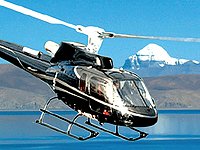- Home
- Kailash Manasarovar Yatra
- FAQ's (Frequently Asked Questions)
FAQ's (Frequently Asked Questions) for Kailash Mansarovar Yatra 2024
Is passport must?
Yes, a valid passport is a must for undertaking the pilgrims Kailash Mansarovar Yatra.
Does my India Mobile work?
Yes the Indian mobile does work during the Mt. Kailash and Mansarovar Lake Yatra (except the day of Mount Kailash Parikrama), but kindly take international roaming from your provider.
Can a single person or a couple join the group?
Max Holidays organizes Fixed Departure Tours by Land Cruiser and also by Helicopter and the same can be joined subject to availability in the specific departure dates. All our departures are GUARANTEED and any number of person may take part in these departures.
What are the different ways of travelling to Kailash?
There are 4 ways to reach Mount Kailash from India.
1. By road from India. This is a 28-30 day trek but the disadvantage of this trek is that it has to be booked well in advance and there is no certainty that one can go despite being in physical shape, because the number of seats is limited and participants are chosen by a draw by the Ministry of External Affairs, India. About 400 people out of 6000 applicants go for this Yatra each year.
2. By road from Kathmandu and from there by road to Lake Manasarovar at the base of Mount Kailash. One may fly to Kathmandu from Delhi, Varanasi, Kolkata or Mumbai. This is the most popular route for doing Mount Kailash Yatra.
3. Our Helicopter tours of Kailash are perfect choice for those who cannot afford to spend 15-16 days for the Yatra or who are not very comfortable with high altitude road journey. This tour uses fixed wing aircraft for the flight from Kathmandu to Nepalganj and from there to Simikot. From Simikot a helicopter flies to Hilsa. Land cruisers are then used to reach Manasarovar.
4. Tour via Lhasa wherein one will fly to Kathmandu and then to Lhasa by China Air and from there one will visit various towns in Tibet like Shigatse, Gyantse, Lhatse, Prayang etc. and will
reach Mansarovar. On the way back, there are three options :
a. drive back to Lhasa and fly back to Kathmandu
b. drive to Hilsa and fly via Helicopter and fixed wing aircraft to Kathmandu
c. drive back to Kathmandu via Kodari Border (Friendship Bridge).
What kind of fitness is required?
For Kailash Mansarovar Yatra fitness is very crucial. It is advisable to get a medical examination with your regular doctor before you plan to go on Mt. Kailash Yatra. Anyone suffering from back problems may find the long drives over bumpy roads difficult. People suffering from Asthma or any kind of dust allergy are forewarned that the amount of dust on the road necessitates wearing a mask. Apart from that, it is a good idea to prepare in advance with brisk walking, and some regimen of exercise or preferably yoga asanas and pranayama. Eventually, for most people the Kailash parikrama is an act of faith.
What route does the Kailash 15 day tour follow?
After 2 nights at Kathmandu, the group leaves for the Tibet border (Zhangmu) on the 3rd day. There is a 2-night halt at Nyalam, with an additional date for acclimatising to the height. Thereafter halts are at Saga, Paryang and the sacred Lake Manasarovar. This is followed by the 3 day Kailash parikrama. The return route is the same. Each day there is an incredibly beautiful and equally exhausting drive for 8 hours or more, on rough and rugged terrain. There are very few metalled roads in this part of Tibet.
How much walking is required on the 15-day tour?
During the rainy season in Nepal (late June to Sep), there is a strong possibility of landslides en-route to the Tibet border. This stretch varies from 3-5 kms and has to be walked, if required. After that, you will need to walk during the parikrama, if you decide to undertake it. This is a 52-kms / 3 days trek done at an average altitude of 15000 ft and the highest point is the Dolma La (Pass) at 19,500 ft. Attempt walking the entire distance including the trek up the Dolma La only if you are extremely fit physically. If you are reasonably fit, hire a pony (limited numbers available) for the 3-day parikrama (the rate varies but is about Rs 3,500 - 4,500). You will need the yak on Day 2 of the parikrama on the ascent to Dolma La. But knowing the behaviour of the yaks and the yakmen, you should be prepared for walks on the first and last day of the parikrama. On these 2 days the walks are in general over level ground ( i.e. with no major ascents or descents). THere will be a walking for approx. 8 hrs. a day. However, there is the option of not doing the parikrama at all and staying behind at Darchen at ones own cost. We can pick you up after the parikrama.
How should I prepare myself for the 17- 18 day tour?
Both mental and physical fitness is required to complete the trip. It is one of the toughest land journeys which you would have ever taken on earth. Physical preparations include ANY or all of the following: walking 4-5 kms. a day, swimming, playing badminton, jogging, freehand exercise, climbing a 10/20-storey building etc. All this not only helps muscle development but also expands capacity of the lungs, which is vital in high altitudes due to lower levels of oxygen. This is not a yatra in which you can depend on 'palkis' or ponies to take care of you. You have to depend on your own reserves of strength and stamina. Mental preparation means being absolutely positive about wanting to complete the journey. Yoga helps. A medical check up is strongly recommended. Take your personal physician's advice on your participation. If you consume alcohal and smoke, better quit it.
How safe is it for Indians to move around in Katmandu these days? Also given the recent disturbances in Nepal with the insurgents, do you think the road trip in Nepal going north of Kathmandu (i.e. to and from Zhangmu) may have some security problems?
Nepal is pretty safe to travel. Otherwise also, till date in the history of Nepal, moists have never hurt any tourist. Now as moists are also a part of the government, Nepal as a destination becomes even more safe.
What kind of food is served on the tour?
For breakfast one gets high energy and nutritious beverages like complan, bournvita, horlicks along with tea/coffee. There is porridge/cornflakes and the menu alternates pancakes, upma, pakoras etc., and bread with butter/ jams etc. are there. Lunch is generally packed and served at a scenic spot near some water pool. It consists of a tetra pack (Frooti etc) or lime water with glucose, puri/chapatti & vegetables, tinned fruits/sweets, pickle. Dinner is at the campsite and the menu is very varied with soup, Indian, Chinese and European cuisine and a desert. Water collected from streams near the campsite is boiled and hence safe for drinking. You can add iodine drops or chlorine tablets.
Which is the best time to go on the tour?
While tours operate from April to September in that region, please check the fixed day tours, and itinerary for details on dates. The Tibet plateau is a dry region and rain/precipitation is very little so any month between May-September is good except for August when you can expect heavy rainfall in Tibet. Weather wise although May and September will be colder. However, June-Sep, is the rainy season in Nepal and on the road to the border, landslides do take place and might require a 5-6 km walk on extreme cases. Weather in Tibet is very uncertain.
What is the layout of the campsites?
Campsites have excellent locations usually next to a clean water source. Sleeping tents are laid out next to each other. The dining tent (with table & chairs) and the kitchen tent are near the water source. The toilet tents are at an extreme end of the campsite. The toilets have dug-pit loos. High altitude sleeping bags and carry mats which can withstand very low temperatures are provided.
Some useful tips :
- Try and make friends with the Tibetan guide and driver. They may appear stand-offish initially but are warm and simple people. Small gifts like Hindi movie cassettes, dark glasses, a cap/hat etc. go a long way in overcoming language problems and establishing rapport.
- The first two to three days are particularly tough as you get used to the rigours of the journey and acclimatise to the sudden change of altitude. This can cause breathlessness, lethargy, drowsiness, nausea, lack of appetite, sleeplessness, headache, irritation, anger, lack of judgement. Drink plenty of water (4-5 litres a day), remain calm and quiet, avoid petty arguments, rest as much as possible, eat properly at mealtimes. Talk to the helpful and caring staff and inform them of any difficulties.
- If you are not allergic to sulpha drugs (please consult your physician), take one tablet of Diamox at Kathmandu the night before leaving for Tibet as well as on the 2nd and 3rd nights, or even longer. Alternatively, take half tablet in the morning and half in the evening. Now a days, we do have non-sulphar drugs available by Ranbaxy. Oxygen cylinders and Gamow bags are carried for anyone having major problems.
- If you can't do the parikrama, say so. Don't take the altitude lightly. Many people understand at Darchen that the parikrama cannot be done by them and decide accordingly. We will make alternate arrangements for you to stay back at Darchen (at extra cost payable directly to the lodge, approx Rs.2, 500).
Kailash Manasarovar Yatra General Information

Ready to book ?
Contact our Kailash Yatra expert VIDUSHI SHARMA






